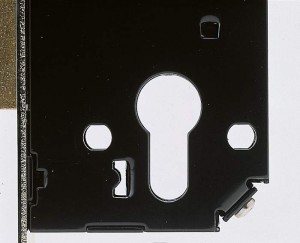The security escutcheon, or defender, is a powerful shield that protects European profile cylinders against the most common attacks. In order for it to be fitted the lock must normally have special 2 holes for inserting the fastening screws, but if these are not present (either because the lock is simply not provided with them or because it is a version for metal sections where there is not the actual space to make them) the cylinder can still be protected with a universal security escutcheon.The fixing of the security escutcheon from the inside using screws which pass through the entire thickness of the door and enter the lock is the most secure solution, since the resistance it provides against burglary attempts is very high.
However, unfortunately, in order to install an escutcheon in this way the lock must be provided with special fitting holes, which have a diameter and a specific position, defined by a internationally adopted standard, called “DIN”.
These are not present on many locks, either because the specific model does not provide them or because size does allow for them. For example, the locks to be fitted on narrow profiles, such as those of safety gates or doors with metal frames do not have a sufficiently large case to house them.
However, a universal escutcheon, like the one below, can be installed in all these cases.

The Viro universal escutcheon can be fitted on practically all locks with European cylinders, even if they do not have DIN holes.
The particular shape and small size make it also suitable for the metal sections of gates and French doors, such as those found, for example, at the entrance to shops. Of course, if the glass of the door is just normal glass then protecting the cylinder does not make much sense, as it is the glass which is the weak link. But if it is breakthrough resistant glass then the cylinder may be the weak link which needs reinforcing.
This escutcheon is fixed on a plate positioned on the outer side of the door.
This is in turn fixed to the door using a contrast plate inserted inside the lock chamber.

Contrast plate inserted inside the lock chamber to which the mounting plate is attached on the outside.
Firstly, the mounting plate on the outside of the door is screwed to the contrast plate inside the lock chamber. The lock is then inserted in the door, the escutcheon is fixed on the mounting plate and lastly it is locked by inserting the cylinder which, sliding into the escutcheon, holds it in place.
The following video will show you the steps:
This solution is very practical and enables almost any kind of European profile cylinder to be reinforced with the security escutcheon, regardless of the type of lock on which it is mounted… there are now no more excuses for leaving a cylinder defenceless!
The technical features of the universal security escutcheon can be seen here





Thanks to the terrific manual